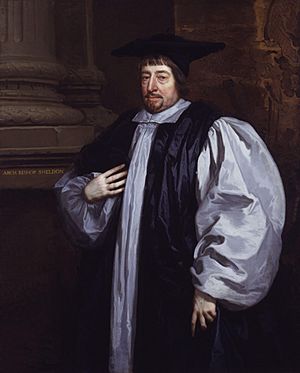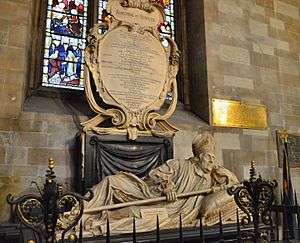Gilbert Sheldon facts for kids
Quick facts for kids The Most Reverend and Right Honourable Gilbert Sheldon |
|
|---|---|
| Archbishop of Canterbury | |

Portrait by Peter Lely
|
|
| Church | Church of England |
| Province | Province of Canterbury |
| Diocese | Diocese of Canterbury |
| Elected | 11 August 1663 (elected); 31 August 1663 (election confirmed) |
| Enthroned | 7 September 1663 (by proxy) |
| Reign ended | 9 November 1677 (death) |
| Predecessor | William Juxon |
| Successor | William Sancroft |
| Other posts | Dean of the Chapel Royal (1660–1663) Bishop of London (1660–1663) Master of the Savoy (1660–1663) Chancellor of the University of Oxford (1667–1669) |
| Personal details | |
| Born | 19 June 1598 Stanton, Staffordshire |
| Died | 9 November 1677 (aged 79) Lambeth Palace, Surrey |
| Buried | Croydon parish church, Surrey |
| Nationality | English |
| Denomination | Anglican |
| Parents | Roger Sheldon |
| Profession | Theologian |
| Alma mater | Trinity College, Oxford |
Gilbert Sheldon (born June 19, 1598 – died November 9, 1677) was an important English religious leader. He served as the Archbishop of Canterbury from 1663 until his death. This was the highest position in the Church of England.
Contents
Early Life and Education
Gilbert Sheldon was born in Stanton, Staffordshire, England, on June 19, 1598. He was the youngest son of Roger Sheldon, whose father worked for a powerful nobleman, the Earl of Shrewsbury.
Gilbert went to Trinity College, Oxford, starting in 1614. He earned his first degree, a Bachelor of Arts (BA), in 1617. Later, he received his Master of Arts (MA) in 1620.
In 1622, he became a fellow at All Souls' College, Oxford. He continued his studies, earning degrees in Divinity. He was ordained as a priest in 1622. Soon after, he became a private chaplain to a famous lawyer, Thomas Coventry.
Rising Through the Church
In 1636, Gilbert Sheldon became the head (warden) of All Souls' College. He became friends with William Laud, who was then the Archbishop of Canterbury. Sheldon also became close with other important figures like Edward Hyde.
During the 1630s, he held several church positions, including being a prebendary (a type of clergyman) at Gloucester Cathedral. He was known for not agreeing with the Puritan movement, which wanted to "purify" the Church of England.
During the English Civil War
Gilbert Sheldon was a strong supporter of the King during the English Civil War. He was involved in peace talks in 1645. He was one of the church leaders closest to King Charles I. He stayed with the King in Oxford and later on the Isle of Wight.
When Parliament's forces took over Oxford in 1646, Sheldon was removed from his position at All Souls' College. He was even arrested for a short time. After his release, he lived quietly for about twelve years. He stayed with friends in different parts of England and Wales.
During this time, he secretly helped raise money for poor clergy members. He also supported King Charles II, who was living in exile. In 1659, he was able to return to his role as warden of All Souls' College.
Bishop of London
After the monarchy was restored in 1660, Gilbert Sheldon's career quickly advanced. On September 21, 1660, he was chosen to be the Bishop of London. He was officially confirmed in this role on October 23.
He was consecrated (made a bishop) in Westminster Abbey on October 28, 1660. Around this time, he also became the Dean of the Chapel Royal and Master of the Savoy.
The Archbishop of Canterbury at the time, William Juxon, was very old and unwell. Because of this, Sheldon took on many of the Archbishop's duties. He also became a member of the King's Privy Council, which advised the King.
The Savoy Conference
In 1661, a meeting called the Savoy Conference was held at Sheldon's home. The goal was to discuss changes to the Book of Common Prayer, which is used in Anglican services. Sheldon played a key role behind the scenes.
He believed that the Puritan objections to the prayer book should be heard. However, he also wanted to make sure the Church of England remained strong and traditional. The conference led to the Uniformity Act 1662. This law made sure that everyone in the Church of England followed the same rules and used the same prayer book. This act was very much in line with Sheldon's views.
Archbishop of Canterbury
In 1663, Gilbert Sheldon was chosen to become the Archbishop of Canterbury. This was the highest position in the Church of England. He officially took on this role on August 31, 1663.
Sheldon cared deeply about the University of Oxford. In 1667, he became the Chancellor of the University. He used his own money to build and support the Sheldonian Theatre at Oxford. This famous building is still used today for university ceremonies.
He also became a member of the Royal Society in 1665. This is a famous group that promotes science.
Later Years and Legacy
Sheldon often took on important non-religious tasks for the King. He helped settle disputes and investigated matters related to the navy. However, he lost some political influence after 1667. This was partly because he openly criticized King Charles II's personal life. He also spoke out against the King's Declaration of Indulgence in 1672, which aimed to give more religious freedom to non-Anglicans.
Gilbert Sheldon never married. He was known as a "stout and high spirited man" who was not afraid to speak his mind to the King about important moral issues.
He passed away on November 9, 1677, at Lambeth Palace. He was buried in Croydon parish church, which is now known as Croydon Minster.


